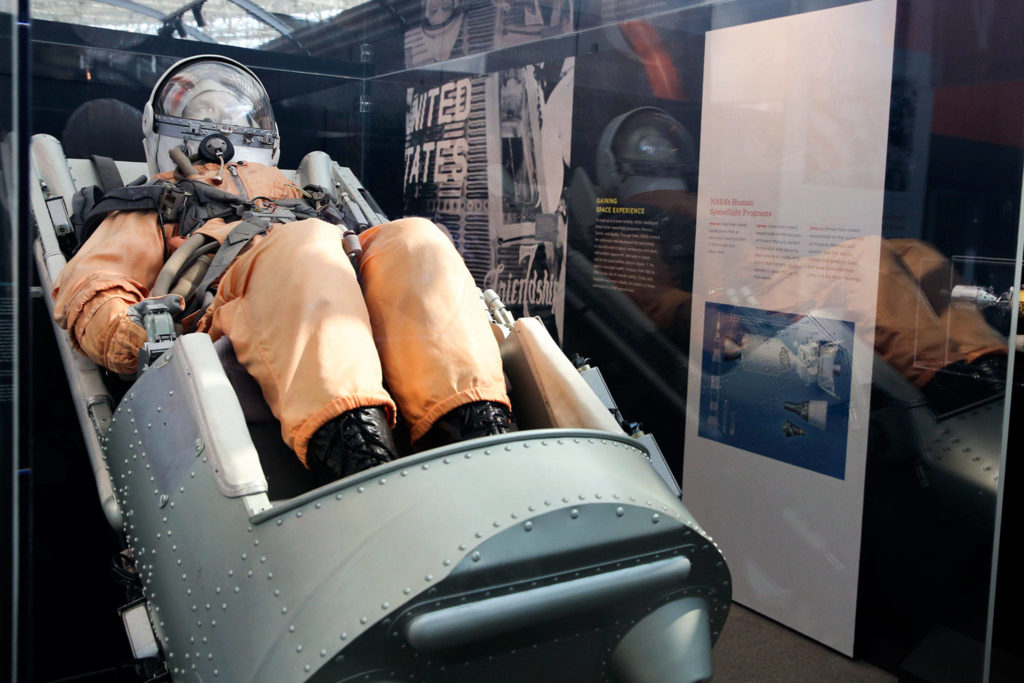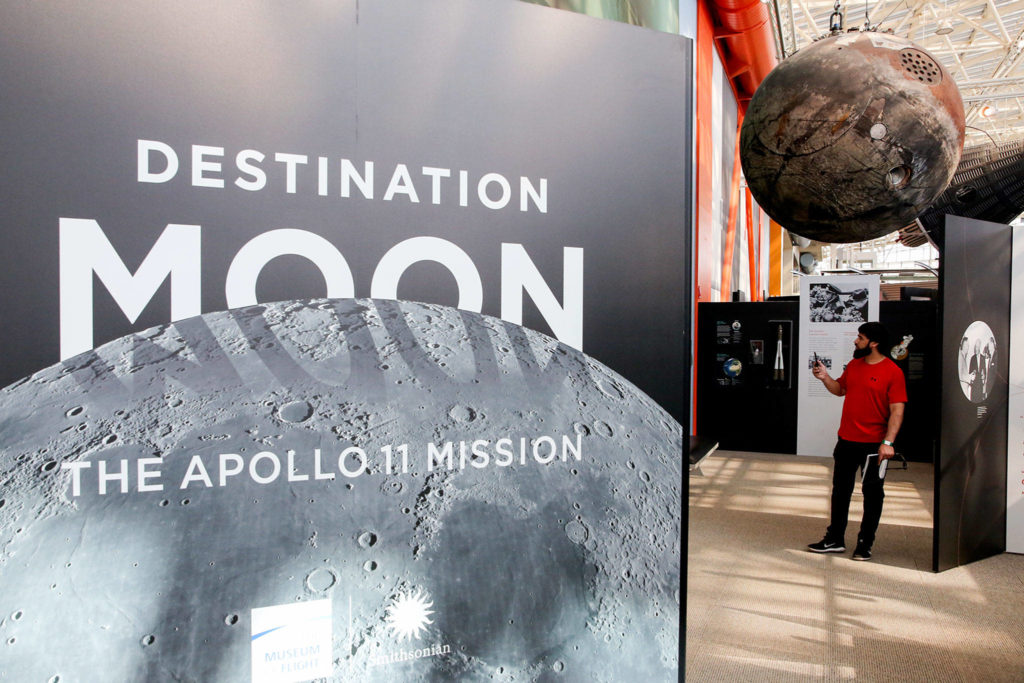SEATTLE — I was visiting Museum of Flight’s exhibit, “Destination Moon: The Apollo 11 Mission,” when I overheard a surprising comment from another museum-goer.
“We stopped going to the moon because it was too expensive and pointless,” the man said to his friend as they stood just a few feet away from one of humanity’s greatest achievements: Apollo 11’s command module, “Columbia,” the centerpiece of the exhibit on display through Sept. 2.
The 13.5-ton vessel orbited the moon as Neil Armstrong and Buzz Aldrin became the first humans to land on the moon on July 20, 1969, then returned them and command module pilot Michael Collins to Earth. The exhibit coincides with the moon landing’s 50th anniversary.
The Museum of Flight exhibit is a gold mine for space nerds like myself. It’s hard to imagine a better place to spend the anniversary than getting close-up looks at dozens of artifacts from the Apollo program on loan from the Smithsonian’s National Air and Space Museum. Among those artifacts:
The spacesuit visor and gloves Aldrin wore on the moon (if you look closely enough, you can read the instructions Buzz followed on the lunar surface). The felt pen Aldrin used to activate a broken circuit breaker to help their lunar module, “Eagle,” lift off from the moon. Moon rocks and the box the Apollo 11 crew collected them in.
It’s all historic stuff.
The museum added its own collection of NASA and Soviet spaceflight treasures to tell a more comprehensive story of the international space race, including the role our state played in it, through artifacts, photos, stories, film footage and transmissions.
“It’s not only a reminder of an incredible time that can’t be repeated, but it also comes at a time when a new space race is underway,” said Ted Huetter, a Museum of Flight spokesman. “We’re undertaking the same type of adventures, but now in new ways. If you’re excited about going to Mars now, well, here’s what inspired them.”
I went with my dad, who, in 1969, saw Apollo 11’s Saturn V rocket up close, thanks to a friend who worked at NASA.
We weren’t disappointed. In fact, we were blown away by the one-of-a-kind artifacts on display. And we appreciated how the exhibit highlighted others critical to the space program, not just the astronauts.
I was touched by a tribute to Neil Armstrong, featuring several of the “One Small Step for Man” astronaut’s mementos on loan from his family (his son Mark Armstrong is a trustee at the Museum of Flight). These include his Congressional Space Medal of Honor, parts of the Wright brothers’ 1903 airplane that Armstrong brought with him to the moon and a flight suit he wore to do chores at home after retiring from NASA.
My jaw dropped when I saw a 20-foot-tall, cone-shaped F-1 engine, one of five used to power the 36-story-tall Saturn V rockets into space. Though the Apollo program was canceled before this engine was put to work, other F-1 parts that made it to space on Apollos 11, 12 and 16 are on display.
The engines were lost in the Atlantic Ocean for more than 40 years — at a depth lower than the wrecked Titanic — until Amazon founder Jeff Bezos funded an expedition to recover them in 2012 and 2013; he’s one of several sponsors of the museum who assured the artifacts from the Smithsonian would be there for the 50th anniversary.
A replica of a lunar module hangs above a moon rock collected by Apollo 12. One day, if we return, the same kind of rock — a type of igneous rock called ilmenite basalt — may be used for building lunar bases.
The exhibit concludes with Apollo 11’s 24-by-12-foot command module, which looks like a cramped place for three men.
Dad and I were both at a loss for words. My dad kept shaking his head as he took everything in.
“This is just crazy,” he finally said.
It’s hard to fathom Columbia’s journey 50 years ago, from circling the moon to its fiery return to Earth. I still struggle to grasp the bigger picture of all six Apollo moon landings.
But pointless? No way, and you don’t have to be a rocket scientist to figure that out.
Evan Thompson: 425-339-3427, ethompson@heraldnet.com. Twitter: @ByEvanThompson.
If you go
“Destination Moon: The Apollo 11 Mission” is on display through Sept. 2 at the Museum of Flight, 9404 E. Marginal Way S., Seattle. Museum hours are 10 a.m. to 5 p.m. daily.
Admission is $35 for adults, $31 for seniors and $26 for ages 5-17; kids ages 4 and younger get in free. Tours are timed; the final tour time starts at 4:20 p.m.
Lunar Block Party
A three-day celebration of the moon landing’s 50th anniversary is set for July 19-21 in the museum parking lot. There will be live music, food trucks, games and activities, a classic car show and an outdoor movie.
Call 206-764-5700 or go to www.museumofflight.org for more information.
Talk to us
> Give us your news tips.
> Send us a letter to the editor.
> More Herald contact information.




























